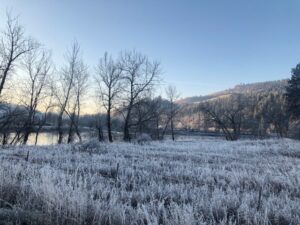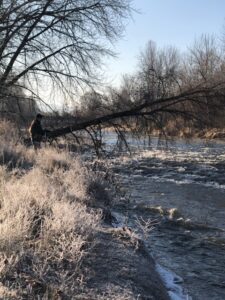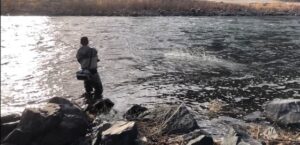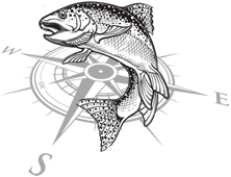 Most people like to catch fish when they go fishing. That’s pretty safe to say. Why would any rational person spend hours and hours wading in a literally icy river trying to catch fish that aren’t actively feeding? Especially when you factor in catch and release, there is no logic driving people to chase steelhead on the fly. Is it for the Gram? For the ego? For the soul? Answers will probably vary from person to person. For whatever reason, catching a wild steelhead on the swing has become an obsession of mine. Something drives me to get out in the big water with a spey rod and some feathers to chase these unicorns of the trout world.
Most people like to catch fish when they go fishing. That’s pretty safe to say. Why would any rational person spend hours and hours wading in a literally icy river trying to catch fish that aren’t actively feeding? Especially when you factor in catch and release, there is no logic driving people to chase steelhead on the fly. Is it for the Gram? For the ego? For the soul? Answers will probably vary from person to person. For whatever reason, catching a wild steelhead on the swing has become an obsession of mine. Something drives me to get out in the big water with a spey rod and some feathers to chase these unicorns of the trout world.
Last week I had the opportunity to slip out of town with my parents/quarantine-fishing-buddies to spend four days on an a steelheading trip. My mom was happy to come on the trip but gave a hard pass to the idea of winter steelheading. I thought she was crazy and she thought I was too. My dad bought his first spey rod this year from a reputable manufacturer, only to have it literally break in half when he was getting a casting lesson in town. The thing sheared into two pieces just above the grip. Of course, he got a free replacement from the shop he bought it from, another 13 foot 7 weight that survived the casting practice and joined us on our adventure. We drove up to Riggins and spent the rest of the day cast-swing-stepping down a run by the Twin Bridges access point on the Salmon River. We spent the night in their RV and found another piece of water to start on the next day. I set both of our rods up with sink tips and lightly weighted Hoh Bo Spey flies. It was about three hours into the second day of our trip when I noticed my dad was standing in the river holding half of a spey rod. He was too far away for me to hear what he was saying, but it probably wasn’t a glowing review of his new rod….
His replacement rod broke in the same clean way. It wasn’t operator error; he had been fishing for maybe 8 hours total and was only roll casting downstream to get the sink tip to the surface when it snapped. Bad batch of fly rods…. Bummer. Unfortunately we had two more days of fishing left and didn’t have a backup spey rod. However, I did bring by 9 foot 8 weight for nymphing so now he had the opportunity to get reacquainted with the “bobbers” we rarely use since learning to tight-line nymph for trout. We had been hearing that people were getting into a lot of fish on the South Fork of the Clearwater up by Kooskia which is much more fishable with a single handed rod, so we cut our time on the Salmon short and drove up North.

This was the first time either of us had been to this part of the Clearwater River so we had a lot to learn. We talked to local fishermen, fished what seemed like miles of river and landed one whitefish and a fall chinook that was closer to dead than alive. The good thing about this was that we answered a lot of questions that we had about fishing the SF Clearwater; where we could find good holding water, swingable runs, and access points. On our last full day of fishing we had just finished fishing a run and were walking back to the RV when we bumped into a Steelhead guide and fish biologist who worked for the Nez Perce Department of Fisheries. He told us that the recent precipitation had actually caused the steelhead to move out of the South Fork and back into the main Clearwater. Our adventure wasn’t a waste of time though, now we know where to fish and what the water is like in all of those places. If we go back in February when there are actually steelhead in the river we can confidently work the water and will probably catch one or more.
The last day of our trip started with fishing the confluence of the South Fork and Middle Forks of the Clearwater. No luck, and since we were heading home that night we decided to head back to the Salmon River for the rest of the day. We stopped at Whitebird to fish a run just below where the creek comes in. I was getting consistent casts and slow, deep swings with 10 feet of T-12 as a sink tip. I was getting into the end of the run where the river drops off into a deep bucket of slower water and decided to put a heavier fly on. Something told me it was a good idea. I worked the line back out casting about 4 more feet of fly line each cast when I got the first grab of the day. Oddly enough it grabbed the fly when I was almost done stripping in the shooting line and I was not expecting that. I stopped stripping and waited to feel the weight of the fish as it turned with the fly, but it never happened. Just four heavy pulls and then nothing. I laughed at myself wondering if I should have kept stripping; if that would have set the hook or not. I took a few steps upstream and started working line out again, trying to put the fly back in the zone where that fish was. A few casts later the line went tight and I set the hook. Fish on! I saw the silver side of a steelhead shaking its head in the water and 5 seconds later it was off. I pulled in my fly to check the hook and there was a snagged caddisfly case blocking most of the hook gap. Oh well. The moral of the story is, check your hook when you miss a fish the FIRST time. 

